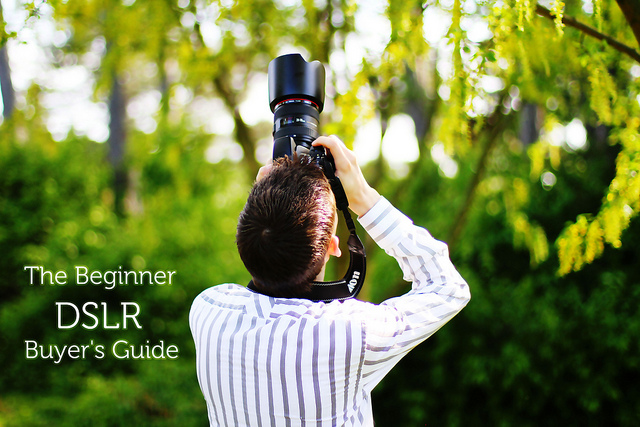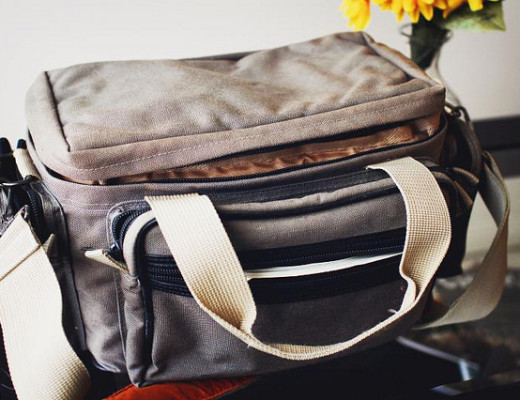
I want to start this guide with a full disclosure. I own a Canon, and though I have done significant research on Nikon for the sake of this guide, I just don’t have the four+ years of experience (and I’m no expert!) that I do for Canon, so please keep that in mind. I am not endorsed by either Canon or Nikon, and I have written this guide based on my own experiences only. I have spent a lot of time and energy helping Flickr users, readers, or friends on an individual basis shop for their first DSLR, and while I’ll still happily answer any questions you might have or help you personally shop for “what’s right for you”, I’ve decided to put together this little resource guide as a good starting point for anyone looking to purchase a DSLR. Since this is a beginner’s guide, I will try to keep all of the technical speak to a minimum. After you read this, you can browse among the hundred other really great reviews out there that include everything before you make your purchase.
Why do I want to purchase a DSLR?
This is the first thing you should ask yourself. Seriously! I know it may sound silly, but really think about it! Your answers can and will vary (family portraits (new baby, perhaps?), hobbyist, photography classes, film is expensive, your point and shoot just isn’t good enough anymore, etc) but the common link should be the word “quality”. If you want quality photographs, the flexibility and control that a DSLR offers, and the experience of quality lenses, then this is the guide for you.
It’s all in the glass.
Now listen up, folks, and listen well. You can have the best body in the world, but if you’re carting around a 15-55mm standard kit lens, it won’t make a lick of difference. This is the most important part of this guide, so if you read nothing else, read this: Your body can last you a good four to six years, at least! But your lenses will last you much, much longer. Buy quality lenses. When you’re buying a DSLR for the first time, your focus should be more on the lens than the body, which is not something you’d think as first time buyer! For example, if you’re looking at a 50mm 1.4 and a Canon T2i, but you can’t afford both, drop your body to the Canon T1i instead of dropping your lens to the 50mm 1.8. A good piece of glass is worth every shiny penny.
So recommend something, already!

Nikon has some really, really promising entry level cameras for a lower price than Canon, but if video is important to you, or if you’re looking to get a better intermediate camera eventually, you might want to go with Canon. From what I’ve seen, Nikon has some really fantastic entry level options, and then some fantastic top of the line professional equipment, but not much in between. Which is better? Honestly, they are both great. They have differences and similarities, but what it boils down to is personal preference. Why did I go with Canon? Both my manual camera and first digital point and shoot were Canon, so I was familiar with the interface. That’s it! No big secret there!
The Nikon D5000
The Nikon D5000 is a great starter option. It’s almost the same camera as Nikon’s D90, save a few minor (or are they?) details, but since the kit for the D90 is a thousand dollars, it will be included in the intermediate guide. (If money isn’t an obstacle for you, and you want Nikon, go for the D90!) If you’re just looking for entry level photography (family photos, trips, something for your purse) and that’s it, I’d go with the D5000 and get a banging lens. If you’re more of an enthusiast and find yourself in love with photography, go for the D90 and you won’t regret it. They both use the same sensor (which also happens to be the same sensor as the D300S!) If you plan on filming home movies or doing a lot of video as well as photography, you should see the Canon T1i below.
The Canon T1i aka 500D
Well, my first move was to research the T2i, simply because it was the upgraded version, but I kept coming back to this bad boy. Why? Because the T2i was a thousand dollars, and if you’re going to spend that much, spend it on an intermediate body. The T1i is a powerful camera providing pro-like image quality, fabulous video, and has the advantage of being small and light weight. See a fabulous and detailed overview here. Again, if you’re looking for intermediate my recommendation is the 50D, but I have a sneaking suspicion a newer model is going to be released soon.
The Lenses
Now, I can really only in good conscious recommend lenses for Canon users because that’s what I know from experience. Perhaps a Nikon user I trust (Emily? Bronwyn? Diana?) would be willing to write a sister guide for the Nikon lenses (or even bodies too!) and we could link to each other! For now, this is what I recommend for those going with a Canon body.
For those of you looking for an “all purpose” lens that zooms, I’d recommend the 28-135mm f/3.5-5.6. What you should know, however, is that though the zoom is handy and nice to have, the “3.5-5.6” number part means it’s not so good indoors. The lower that number, the faster the lens, and the smaller the focal point can go. Generally speaking, if you want a number lower than 3 (more light is let in, faster, etc) you’re looking at a prime lens (unless you’re willing to pay a lot more.) So if you’ve been browsing Flickr and you’re looking for that smooth, silky look with a small sharp object in part of the photo- they’re probably using a prime. Or at least a lens with a lower number. (This number is called an f/stop, in case you were wondering.) But if you aren’t looking to shoot indoors or in other low light conditions, and zoom is really important to you, then this is the lens for you. If you’re looking for a lens that is great indoors and outdoors, and you don’t mind not having a zoom, go prime!
I recommend the 50mm f/1.4 (this is what I have, it’s love), or the 85mm f/1.8, or if macro food photography/insects/flowers/ is more your thing, I’d recommend the 100mm f/2.0. I’m trying to keep this list short, and which lens you buy is based entirely on how you plan on using your camera, but if it helps, I have been using a 50mm f/1.4 every day since I picked it up. Almost every shot you’ve seen on this site (as of May 18th, 2010) was taken with a starter Canon XTi and a 50mm f/1.4. The 50mm is the most commonly purchased lens out there.
I feel I should note one more thing, however, and that’s if you’ve gone with the T1i, because it’s a crop sensor, the 50mm will act more like an 80mm in that it’s quite close to your subject! You have to back up pretty far for family shots, they have to squeeze in, and arms length self portraits are pretty much out of the question. If the 50mm is too close for you, I’d recommend a 30mm or 35mm instead. Now, if you’re looking for an f/stop lower than 2.0 in the same price range as these other lenses, an off brand (specifically a Sigma 30mm) is recommended. (2.0 is my favorite f/stop, so I wouldn’t mind.)
Well, that about wraps it up for the beginners guide. If I’ve left anything out or you have any further questions, please feel free to let me know via comments or email. I hope this helps you!
*Originally I included more cameras in this guide but then it was super long and really in my opinion these are the best choices for beginners, but they certainly aren’t the only choice! If you have any more questions about specific camera bodies and want to just shoot me an email, I will happily help!





23 Comments
Fran
11 Jan 2011 at 9:36 pmHi Sara! I sent you an email a few days ago but maybe you didn’t get it or were too busy to answer it, so I thought I would ask you here and you can answer when you have some time, I don’t want to bother you :p This is the email I sent you:
I have been an admirer of your photography for a while now, and I would love to ask you for some advice if you are not too busy. I have been saving for a while ’cause I’m interested in buying my first DSLR camera, I really want to do more that what I can with my point and shoot, and have more quality in my photos. I read your Beginner DSLR Buyer’s Guide, and I think I’m going with the Canon 500D. My only problem is that I don’t know what to do with the lense. I only have enough money for the body and one lense, so I don’t know if I should buy the body with the kit lense or the body with the 50 mm f/1.4. The only reason I’m doubting my choice is because of the zoom. I know that with the second choice I wouldn’t have any, but for what I read on your guide and some other sites it seems much better. Besides, something tells me that the zoom isn’t really that much of a big deal. I’m sorry if I don’t make much sense, I’m really confused :p Oh! also, have you taken videos with 50 mm? did they turn out ok?
I really want to be able to achieve that warm feeling your photos have, and a focus with a blur background. Any advice would be really appreciated, but if you are too busy don’t worry about it! 🙂 And sorry if I sound too much like a noob, the truth is that I am one :p
Also, congratulations on your wedding! I didn’t leave a comment on your site ’cause for some reason I didn’t dare to leave one. But I honestly wish you the best and lots of moments filled with joy and happiness.
Wishing you the best,
Fran.
p.s: Sorry if my english sucks, it’s not my first language.
Sara
13 Jan 2011 at 8:07 pmHi Fran, I emailed you back!!
(In case anyone else looks at this- I ended up recommending her the 50mm 1.4 lens over the kit and gave a two thumbs up to the Canon 500D.)
Patrick
3 Sep 2010 at 1:19 pmThank you for such a wonderful writeup! Being new to photography, I never realized the “real” importance of a good lens. I have been using the zoom/kit lens with my D90 ever since I first picked it up. But you have convinced me of the value in having a good prime lens, and I plan to go purchase one this weekend. Thanks!
On a related note… great website! I found it when I was first trying to settle on a software platform for photoblogging. Wonderful photos, and I really like the layout / presentation here. Thank you for some badly needed inspiration!
Sara
5 Sep 2010 at 9:48 amThanks for the comment, Patrick! I’m excited for you and your new prime! Which one did you settle on?
(I’m checking out your website right now!)
Patrick
6 Sep 2010 at 10:20 amI picked up a Nikon 50mm f/1.4 and hope to try it out today. I could have easily gone with the Sigma based on its reviews, but none of the camera suppliers around here stock it (and I guess I was too impatient to order one).
abhinav
14 Jun 2010 at 1:46 pmWonderful guide for N00bs 🙂 .Very nice write up .I will forward this article to my friends .
Amanda
23 May 2010 at 10:00 amThank you for doing this! I am new to my DSLR and this is just what I needed because Im sick of the 18-55 lens that came with my Canon EOS Rebel XS. It has been great for the past 5 months but the more I learn the more limitations I run into. I love macro photography and have been looking at my options but I was in the dark 🙂 I will try your suggestion and order the 100mm f/2.0 that you linked to.
Sara
23 May 2010 at 2:15 pmThanks for commenting, Amanda! I ran into the same problem you did! I was given the advice to drop the kit lens and pick up something else from pretty much everyone I spoke to, but they all had different recommendations! It’s mostly because until you know how YOU personally are going to use the camera and what photos you’re going to enjoy taking, how are you to know which lens to get?
I was in love with my camera when I first got it and used it on a daily basis but would get frustrated when I was trying to do indoor shots. I very quickly learned that I was limited and it wasn’t because of my camera!
Let me know how the 100mm f/2.0 goes (2.0 is my favorite F/stop!), I’d love to be able to post a revisit to this!
Kim
22 May 2010 at 2:02 pmHah! You know, I just might. 😉 I don’t have a WHOLE lot of experience with many other lenses but I have been fortunate enough to tinker with a few high-end lenses as well as the more affordable options that I own.
I was really surprised on Flickr when you’d mentioned reading bad reviews of the Sigma 30/1.4– I’ve never had any problems with it pr the focusing whatsoever, it’s been an absolute dream to me! It’s the only lens I took on our 2 month trip to Thailand and it’s basically never left my camera’s side since I bought it in college.
I’ve never seen Canon’s 50/1.8 but your description sounds like a huge YIKES! From what I’ve read, the Nikon versions of 50/1.8 and 1.4 aren’t too amazingly different, at least from the beginner/casual shooter’s PoV. Most reviews I read stated that, unless you’re concerned with barrel distortion, shooting in more rugged environments, that extra stop, etc. it’s not worth the $$$kerching$$$. I shot with one a bit while I was in school and I honestly couldn’t tell the difference! Then again, I’m no pro, so *shrug*.
Ok. Maybe I SHOULD write that sister lens guide, ‘cos it sure sounds like I’ve already gotten a head start here on your blog. I sure know how to blab– Zipping my lips now!
Sara
23 May 2010 at 2:11 pmI’m definitely no pro either, I can only give advice based on my experience, but I wish there had been something like this for me when I started. When you’re first starting out you can be really passionate but get all tangled up in the jargon and seven page reviews out there!
I read some great reviews on the Sigma 30mm 1.4 for the Nikon mount, but it wasn’t so hot for the Canon. I think it would still be worth it though, because I don’t mind returning it until I get one that focuses properly. Most of the reviews said once they got one that worked, they were in heaven! It’s not that I don’t love my 50mm, but I’d like something to be more like a 50mm on my crop sensor!
Kim
20 May 2010 at 1:31 pmThis is a great guide, and I’m always telling people who ask me for advice to put the most focus on their lenses, BUT, I wouldn’t really include the 1.4 in a beginner’s guide. Heck, I’m in the middle of trying to transition myself into professional photography and I still don’t own a single 1.4 lens! They’re just too expensive, and my 50/1.8 lens that only cost $120 instead of $350 has never failed me.
Kim
20 May 2010 at 1:32 pmDid I just say I don’t own a single 1.4 lens? Because that’s obviously a lie. This is what happens when you catch up on blogs 5 minutes after rolling out of bed. Still! It took me years after I bought my first dSLR before I got my Sigma 30/1.4, so… Yeah! I think I saved face there, maybe a little? 😉
Sara
22 May 2010 at 11:48 amI knew you owned a 30mm but I didn’t know it was 1.4, haha. I think I would have recommended the 1.8 for the 50mm, but at least for Canon, it’s really cheap and it shows. I think it’s $80 or something and you can definitely tell. When I held it I felt like I was going to break it. And before I bought mine I scoured forums and heard several users mention them breaking within a year of use! I can’t in good conscious recommend something I was leery about myself! BUT, I imagine they’re better from Nikon (Bronwyn is rocking the 50mm D), or even Sigma. Did you have any front focusing issues with your Sigma?
Also, *cough* perhaps you should write a sister lens guide for Nikon users. Ahem. Just maybe.
Alyssa
19 May 2010 at 8:53 amThank you, Sara! As you know, I LOVE my 50 mm f/1.4 prime, but I’ve been looking for a good walk-around lens. Sadly I haven’t been able to try any out, so your recommendation helps a lot! There are a few around the same price that look very similar
Sara
19 May 2010 at 5:39 pmI’m in the same boat as you! I love my nifty fifty, but it’s a biiiit close sometimes when I’m walking around outside or even trying to take a photo of my meal at a restaurant. I have to reaaally back up or sometimes even stand up. Haha.
Peregrine
19 May 2010 at 4:54 amGreat buyer’s guide! Thank you for sharing your knowledge with us, Sara. I use a Sony Alpha (and before that, a 10+ year-old Canon SLR!), so any opinion I give would probably be irrelevant or outdated. However, having read your recommended lenses, it’s good to know I have made the right choices, even though I decided to go with a less popular brand ^_^.
Thanks again!
Sara
19 May 2010 at 5:38 pmIt’s not always in the brand! I tend to stick with the Canon lenses because sometimes they’ll upgrade their body and the old Sigma/Tamron lenses won’t work anymore, but your Canon lens always will! I guess I’m paranoid and want to make sure the investment lasts for as long as yours has!
Ashling
19 May 2010 at 3:14 amThis is grand ^_^ One more thing that confused me as a beginner is that Canon cameras have different names depending on where you are: T1i = 500D and T2i = 550D
I’m very happy with my 500D, even though I only have kit lenses ^_^;
Thanks Sara!
Sara
19 May 2010 at 5:31 pmThis is a really good point! I’ve updated to include the other name! Luckily though, your “kit lenses” aren’t actually kit at all. They are better than the kit lens that comes with the North American package. =}
Diane
19 May 2010 at 12:55 amThanks so much for this, Sara! I always loveee your photos and this guide is perfect. I couldn’t agree more with the prime lenses! My first and only lens that I’ve been able to purchase was a f/1.8 and though I regret to say I only started putting it to good use in the last year/2 years it really was a great buy!
I’ve had my camera since junior year of h.s….a little over 4 years! The body is pretty banged up and I really need to get my sensor cleaned [hopefully those spots on my photos is just dust!] But I have been entertaining the idea of getting a new body soon! This helps 🙂
I have a pretty reliable video camera so I don’t want a dslr with video but I know that I’ll be reaching for Canon again 🙂
Sara
19 May 2010 at 5:35 pmThank you, miss! There’s something about primes that once you use them, you never want to go back! Seriously, my “dream team” collection of lenses includes four primes and only one zoom!
Since you’ve had some experience you might want to consider upgrading to an intermediate body, but then again, I would be perfectly content with my little XTi if I wasn’t doing weddings and portraits! I’m glad this helped. =}
Bronwyn
18 May 2010 at 8:10 pmWonderfully written, Sara! I’d add in that the Nikkor kit lens (18-55mm) is reputed to be stronger than the Canon kit lens but I can’t compare that in a fair way, it’s just what I’ve read. The kit lens treated me well and is wonderful to learn with. 🙂 I’d also hasten to add that the D5000 is supposed to be more user friendly than the D90. Now that I own the latter and can see the huge differences between that and the D40 I can see why! For this, I actually need a manual, haha. So the two compared, for a true beginner I’d avoid the D90. The D40 (sidestep to the D5000/D3000) allowed me to tinker with much more ease right out of the box. Perhaps that’s a reflection of my own incompetence, I’m not sure! Also, about third party lenses, there seems to be some gamble among users in terms of quality of build, even among Sigma lenses, so for anyone considering a lens outside of Canon or Nikkor I’d encourage that they try out the actual lens they’re looking at before handing over the cash. Those that get good lenses seem really happy with them but those that get a “dud” sure have a lot to say on the hassles of returning and exchanging! I had no idea this comment would be so long. o.o
Sara
19 May 2010 at 5:32 pmYou know, this whole thing was twice as long and included more than one body recommendation, and I seem to have totally cut the part about Sigmas having front focusing issues!! This is a really good addition to the guide, thanks!